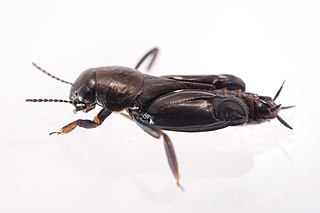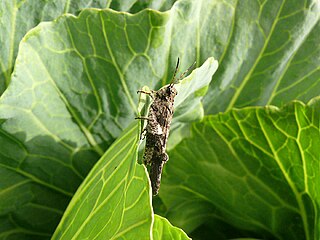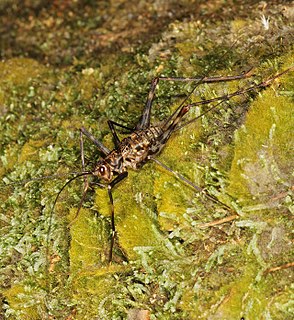
The Eneopterinae are a subfamily of crickets, in the family Gryllidae, based on the type genus Eneoptera. It is one of several groups widely described as "true crickets". Of the more than 500 species that make up this subfamily, most occur in moist, tropical habitats. These insects are medium to large and brown or gray in color. They eat plant leaves, flowers, and fruits and can occasionally cause economic damage. Their eggs are deposited in pith, bark, or wood. Eneopterinae show a great diversity in stridulatory apparatus, signals emitted, and associated behaviour.

Grylloidea is the superfamily of insects, in the order Orthoptera, known as crickets. It includes the "true crickets", scaly crickets, wood crickets and other families, some only known from fossils.

The Trigonopterygoidea are an insect superfamily in the Orthoptera: Caelifera. Sometimes described as leaf grasshoppers, American species in the Xyronotidae have also been called razor-backed bush-hoppers.

The Lathiceridae are a family of grasshoppers, in the Orthoptera: suborder Caelifera. Species in this family can be found in southern Africa.
The Lithidiidae are a family of grasshoppers, in the Orthoptera: suborder Caelifera. Species in this family can be found in Africa.

Tettigoniidea is an infraorder of the order Orthoptera, with six extant families.

Gryllidea is an infraorder that includes crickets and similar insects in the order Orthoptera. There are two superfamilies, and more than 6,000 described species in Gryllidea.

Xya is a genus of pygmy mole crickets, with species recorded from Africa, southern Europe, Asia and Australia.

Oedaleus is a genus of grasshoppers in the family Acrididae.

Rhammatocerus is a genus of grasshoppers in the subfamily Gomphocerinae and the tribe Scyllinini. There are about 16 described species in Rhammatocerus, including R. schistocercoides, the "Mato Grosso locust".

Podoscirtinae is a subfamily of crickets in the family Gryllidae.
Pteronemobius is a genus of cricket in the subfamily Nemobiinae, with a worldwide distribution.

Erucius is a genus of grasshoppers in the family Chorotypidae. Species in this genus can be found in Vietnam and Malesia, including the Philippines. It is the only genus in the subfamily Eruciinae.

Trilophidia is a genus of grasshoppers in the family Acrididae, subfamily Oedipodinae and the only member of the tribe Trilophidiini. The recorded distribution of species is from Africa and the middle-East through to Japan and Malesia.
Pternoscirta is a genus of grasshoppers in the family Acrididae, subfamily Oedipodinae and tribe Locustini. The recorded distribution of species includes: India, China, Indo-China and Malesia.
Gelastorhinus is a genus of grasshoppers in the family Acrididae, subfamily Gomphocerinae.

The Phalangopsidae are a recently reconstituted family of crickets, based on the type genus PhalangopsisServille, 1831 from South America. Priority for family-group names based on this genus dates from Blanchard's "Phalangopsites".

The Cachoplistinae is a subfamily of crickets of the family Phalangopsidae; they are sometimes called beetle crickets. Species are terrestrial, carnivorous or omnivorous and can be found in: Africa, tropical Asia, Korea and Japan.
The Landrevinae are a subfamily of crickets, in the family Gryllidae, based on the type genus Landreva. They are terrestrial, omnivorous and may be known as "bark crickets"; genera are distributed in: Central and South America, Africa, tropical Asia, Korea, Japan, Australia and the Pacific Islands.

Gryllini is a tribe of crickets and typical of the family Gryllidae. Species are terrestrial, carnivorous or omnivorous and can be found in all continenents except Antarctica.















